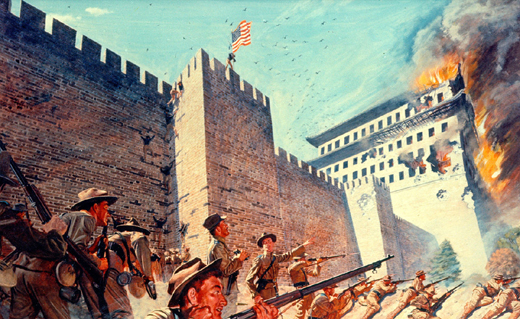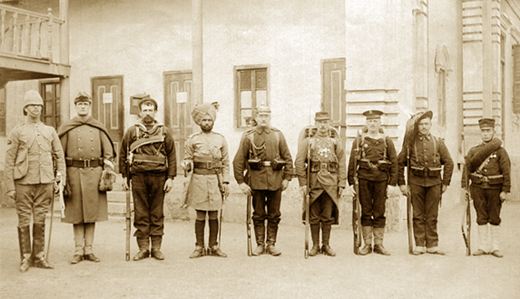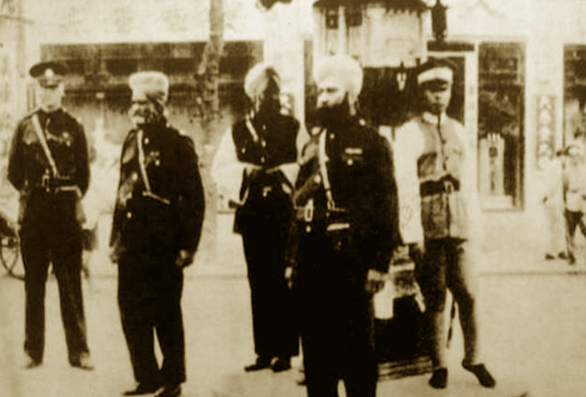The Angry Himalayas – Part VI: Eight Nation Alliance Crushes China in 1900
The Angry Himalayas – Part VI: Eight Nation Alliance Crushes China in 1900
Mangalore Today News Network
By Dr. G. Shreekumar Menon
Mangaluru, September 15, 2020: Yuanmingyuan, the Imperial Palace plays a very curious role in every Chinese defeat. In 1900, an anti-Imperialist and anti-Christian wave of resentment broke out in China.The rebels, mainly young Chinese farmers and workers, kept confined more than 900 foreigners in Beijing’s Foreign Legation Quarter. The siege was the dramatic denouement of months of anti-Imperialist and anti-Christian sentiment that swept across China at the turn of the 20th century. This uprising known as the Boxer Rebellion, cast a long shadow on Chinese history throughout the 20th century.
To quell the Boxer Rebellion and liberate the confined foreigners an Eight-Nation Alliance invaded and occupied Beijing. The alliance force consisted of about 18,000 soldiers, comprising of 4,300 Russian infantry, Cossacks and artillery; 8,000 Japanese infantry; 3,000 British, mostly Indian infantry, cavalry and artillery; 2,500 US soldiers and Marines with artillery; and an 800-man French Brigade with artillery. Austria, Italy, and Germany although they were members of the Eight-Nation Alliance did not make any major military contribution. This battle is also known as Battle of Peking or the Relief of Peking.

Though it is referred to as an Eight Nation Alliance, India was also a part of this Alliance as services of Sikh and Punjab Regiments were utilised by the British. Thus it was technically a 9 nation alliance against the Chinese.
On August 4, 1900, a relief force of more than 3000 soldiers from Sikh and Punjab regiments left Tianjin, part of the larger eight-nation (nine nation) alliance that was dispatched to aid the besieged quarter, where 11 countries had set up legations. Indian troops were also dispatched to guard churches and Christian missionaries, the targets of the Boxer uprisings.
On June 20, 1900, the Boxers, more than 100,000 strong and led by the court of Tzu’u Hzi, besieged the foreigners in Peking’s diplomatic quarter, burned Christian churches in the city, and destroyed the Peking-Tientsin railway line.
The eight nation (nine nation) military alliance was led by Alfred von Waldersee (June 1900 – September 1901) and thereafter by Edward Seymour (September 1900 – September 1901).

(Representative U.S., Indian, French, Italian, British, German, Austro-Hungarian and Japanese military and naval personnel forming part of the Allied forces.)
The Chinese were simply overawed by the sight of the Sikh soldiers and their imposing turbans and fierce moustaches. They feared them very much and so the British deployed Sikh soldiers as law enforcement officers in ports like Shanghai, where their trading companies had set up a large presence by the early twentieth century. The Chinese feared them so much that the British deemed that they did not even need guns when on duty!

The objective of the alliance forces was to fight their way into the city of Peking, make their way to the Legation Quarter and rescue the 900 foreigners besieged there by the Chinese army. Peking had formidable defence fortifications. The city was surrounded by walls 21 miles in length and split up into 16 gates. The wall around the Inner city was 40 feet tall and 40 feet wide at the top. The wall around the adjoining Outer city was 30 feet high. The population living within the walls was estimated to be about one million people
Despite such strong defences, the Alliance forces defeated the Chinese army at the Battle of Beicang (Peitsang) on 5th August and at the Battle of Yangcun (Yangtsun) on 6th August and on 14th of August, the Russian, Japanese and French forces entered Peking. The Chinese were defeated, and Peking wore a battered look. Soon large scale looting and destruction began. The Eight Nation (Nine nation) alliance soldiers went berserk looting, destroying, burning and raping.Yuanmingyuan was devastated once again and the remaining treasures were looted. The soldiers destroyed buildings, sawing off pillars and reducing wooden bridges to piles, and pulled down the trees with large ropes. The destruction of Yuanmingyuan or the Old Summer Palace was complete.
The destruction of the Temple of Heaven deserves special mention. It was the most important of Beijing’s imperial temples. It was where emperors of the Ming and Qing dynasties (from 1420 to 1900) worshiped the God of heaven and prayed for good harvests. It has been described as "a masterpiece of architecture and landscape design". Located in southern Beijing, the Temple of Heaven covers an area of 270 hectares, and is one of the largest existing architectural complexes in the world, with a collection of over 12,000 artefacts.
A gilded bronze bell was looted by a British General from this Temple complex and later gifted to an Indian cavalry unit. The bell, part of a 16-bell set, used to be displayed in front of the Palace of Good Harvest at the Temple of Heaven, where Chinese emperors held annual sacrificial rites to pray for good harvests. The 15 other bells, which date to the 1368-1644 Ming dynasty, remain missing. In 1994 the Indian Army magnanimously returned the bell to the Chinese who hung it back in the Temple of Heaven in Beijing. For this restoration of their prized antique the Chinese are ungrateful.
The 15 other bells, which date to the 1368-1644 Ming dynasty, are still missing, probably in the custody of private museums or millionaires.
Much water has flown under the bridge since the defeat of the Chinese in the Boxer Rebellion. As on 2020, the Chinese have in their expansionist zeal fomented border disputes with more than 18 countries. Apart from territorial disputes, the Chinese have claimed the South China Sea apart from the islands, reefs, banks and other features therein. An estimated US$3.37 trillion worth of global trade passes through the South China Sea annually, which accounts for a third of the global maritime trade. 80 percent of China’s energy imports and 39.5 percent of China’s total trade passes through the South China Sea, hence the greed of the Chinese to possess exclusive maritime rights in this area.
Apart from the territorial disputes with over 18 countries, the Chinese have trade disputes with USA, which can engulf into a global war involving many nations. If in 1900 it was an eight (nine) Nation alliance against the Chinese, 2020-2021 could see more than 21 Nations joining ranks against them.Even an economic blockade can cause severe disruption and uprisings against the present regime in China.
In any future conflict with China, nations should target the Yuanmingyuan again for destruction. It is very dear to the Chinese but yet has played a secret role in every Chinese debacle. Perhaps, the Vastu configuration is not in perfect order. Indians would recall the repeated destruction of the Somnath Temple in Gujarat, over 16 times by Mahmud of Ghazni. Perhaps some Vastu defect in the Temple alignment invited repeated destruction at the hands of a foreign invader. Ultimately, Mahmud of Ghazni was killed by Raja Bhoj King of Malwa kingdom who led an alliance of Kings from other States.
History proves that well-coordinated alliances are effective in containing any enemy.If in 1900 it was the Eight Nation (Nine Nation) alliance that humbled the Chinese, then a 21 nation alliance in 2020 can effectively thwart the aggressive designs of the Chinese Dragon.
Related Article:
Part 1: THE ANGRY HIMALAYAS - String of pearls vs Garland of Opium
Part 2: The Angry Himalayas-Part II: Tibet Needs a Warrior - Monk or Dob-dobs
Part 3: The Angry Himalayas Part III: Opium Wars - How China Lost Vladivostok to Russia
Part IV: The Angry Himalayas - Part IV: Is It time for Opium War III?
Part V: The Angry Himalayas: The Incredible Story of ‘Looty’ the Pekinese Toy - Dog
 Dr. G. Shreekumar Menon IRS (Rtd) Ph.D: Former Director General of National Academy of Customs Indirect Taxes and Narcotics & Multi-Disciplinary School Of Economic Intelligence India; Fellow, James Martin Centre For Non Proliferation Studies, USA; Fellow, Centre for International Trade & Security, University of Georgia, USA; Public Administration, Maxwell School of Public Administration, Syracuse University, U.S.A.; AOTS Scholar, Japan. He can be contacted at shreemenon48@gmail.com
Dr. G. Shreekumar Menon IRS (Rtd) Ph.D: Former Director General of National Academy of Customs Indirect Taxes and Narcotics & Multi-Disciplinary School Of Economic Intelligence India; Fellow, James Martin Centre For Non Proliferation Studies, USA; Fellow, Centre for International Trade & Security, University of Georgia, USA; Public Administration, Maxwell School of Public Administration, Syracuse University, U.S.A.; AOTS Scholar, Japan. He can be contacted at shreemenon48@gmail.com
- Need For ‘Students, Alcohol and Drugs’ survey
- New Synthetic Drugs Trapping Youth
- Mood Modifying Chips - Future of Drug Use
- Ramping up Indo-Bangla border security
- IITM- A premier educational Institution in a forest. What can we learn?
- Former PM, Manmohan Singh: Notable laws passed under his tenure
- Hashish on Ratnagiri Seashore
- The Poor cry out to Us: Do we respond?
- Clandestine Meth Labs Sprouting Across India
- Hydro ganja from Bangkok latest craze among youth in India
- "Memories to Treasure" Dr.Michael Lobo’s new book
- Dominance of Private Universities: Will it make education inaccessible to underprivileged students?
- Monti Phest: A rich heritage of South Canara
- Kashmir Bhavan in Bengaluru: A must visit place
- "MAI and I" Book of Angelic Emotions
- Draupadi Murmu - The New ’President of India’
- Anthony Ashram in the city grows a classic museum
- First College of Fisheries in India - A Golden Jubilarian
- Flushing Meadows - A Vintage Mansion
- The Colonel’s Bequest
- A Mangalorean PM and his RBI Governor Brother: The Extraordinary story of the Benegal Brothers
- There is no higher religion than Truth: Theosophical Society
- L’affaire - Ashu & Yiju of Mangalore
- Mangalore in Kowloon
- 1568 to 2018 AD: 450 years of Christianity in Mangaluru
- Vice President elect Naidu moves on from nadir to zenith, the phenomenal journey
- Embracing the Outdoors: How Heated Jackets Are Revolutionizing Cold Weather Activities
- Efficient and Sustainable Packaging Solutions with FIBCs
- The Hybrid Kilt Revolution | Where Tradition Gets Trendy
- Affordable Elegance | Embrace Style on a Budget with Cheap Kilts
- Unleashing Style and Functionality | Exploring Tactical Kilts
- Mangalore’s Heroic Lady marks 105th Birthday
- Santa the Christmas spirit
- Geriatric care: Mangalore strikes a fine balance
- The Don Who Made Two Empires to Clash
- CHITRAPUR SARASWATS - A Great Kanara Community
- Our new President Ram Nath Kovind’s significant journey to Rashtrapathi Bhavan
- Marriages made in heaven, big fat weddings made in India
- Eid insight - The giver of glad tidings
- CITY INFORMATION
- TRAVEL
- TOURIST INFORMATION
- HEALTH CARE
- MISCELLANEOUS




 Write Comment
Write Comment E-Mail To a Friend
E-Mail To a Friend Facebook
Facebook Twitter
Twitter  Print
Print 


